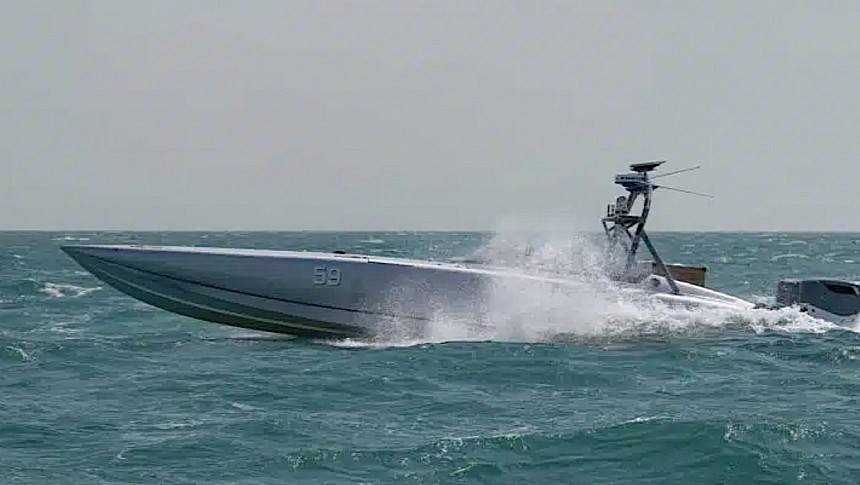It's only a matter of time before autonomous war machines become active participants in conflicts. They already are, to some degree, but I am talking about the time when uncrewed machines will be capable of deciding when and who to hit with deadly force.
The most advanced in this respect are the world's air forces, which constantly deploy such hardware on the battlefields of the world. But naval forces are rapidly catching up, after seeing how successful unmanned maritime assets can be.
The latest development in this field comes from the hot waters of the Middle East. It is there where the U.S. Navy and a defense contractor called Martac Systems achieved what is described as the "first use of lethal munitions from USVs in the Middle East region."
In military slang, USV stands for Unmanned Surface Vehicle and in this particular case refers to something called the T38 Devil Ray. The thing is technically a surface boat with an unassuming look, measuring 38 feet long (12 meters) and powered by a diesel outboard engine.
Thanks to the powerplant, the Devil Ray can reach burst speeds of 69 mph (111 kph). It can carry a payload of as much as 4,500 pounds (2,042 kg).
The boat is equipped with tech (of a secret nature) that gives it new capabilities, such as being remotely operated. It has been undergoing testing for a while now, but it was only during the recent Exercise Digital Talon that it proved its lethal capabilities.
As per the details shared by the Navy, the Devil Ray was involved in teaming scenarios together with NAVCENT Task Force 59, "the Navy’s first Unmanned and Artificial Intelligence Task Force."
The exercise required the drone ship to fire live munitions at a target boat multiple times, and it did so successfully a number of times. The weapon used for the test was a Lethal Miniature Aerial Missile System loitering munition.
The military branch assures us that even if the boat had no humans on board, the firing decision was taken by a human operator based ashore, at an undisclosed distance from the boat.
Such technologies are becoming increasingly important in the area of operations where the tests were conducted. It is there, in and around the Strait of Hormuz, where the Iranian Navy and Islamic Revolutionary Guard Corps routinely operate – in fact, say the Americans, unnamed vehicles, both naval and aerial, are routinely used to track their movements.
Next up for the Navy USV program is an expansion in scale and impact of these tests. According to NAVCENT commander Vice Adm. Brad Cooper, upcoming exercises will include an expansion of the arsenal of combat-capable unmanned systems.
That will most likely include the Saildrones the Navy has also been testing in the area for a while.
The latest development in this field comes from the hot waters of the Middle East. It is there where the U.S. Navy and a defense contractor called Martac Systems achieved what is described as the "first use of lethal munitions from USVs in the Middle East region."
In military slang, USV stands for Unmanned Surface Vehicle and in this particular case refers to something called the T38 Devil Ray. The thing is technically a surface boat with an unassuming look, measuring 38 feet long (12 meters) and powered by a diesel outboard engine.
Thanks to the powerplant, the Devil Ray can reach burst speeds of 69 mph (111 kph). It can carry a payload of as much as 4,500 pounds (2,042 kg).
The boat is equipped with tech (of a secret nature) that gives it new capabilities, such as being remotely operated. It has been undergoing testing for a while now, but it was only during the recent Exercise Digital Talon that it proved its lethal capabilities.
As per the details shared by the Navy, the Devil Ray was involved in teaming scenarios together with NAVCENT Task Force 59, "the Navy’s first Unmanned and Artificial Intelligence Task Force."
The exercise required the drone ship to fire live munitions at a target boat multiple times, and it did so successfully a number of times. The weapon used for the test was a Lethal Miniature Aerial Missile System loitering munition.
The military branch assures us that even if the boat had no humans on board, the firing decision was taken by a human operator based ashore, at an undisclosed distance from the boat.
Such technologies are becoming increasingly important in the area of operations where the tests were conducted. It is there, in and around the Strait of Hormuz, where the Iranian Navy and Islamic Revolutionary Guard Corps routinely operate – in fact, say the Americans, unnamed vehicles, both naval and aerial, are routinely used to track their movements.
Next up for the Navy USV program is an expansion in scale and impact of these tests. According to NAVCENT commander Vice Adm. Brad Cooper, upcoming exercises will include an expansion of the arsenal of combat-capable unmanned systems.
That will most likely include the Saildrones the Navy has also been testing in the area for a while.







